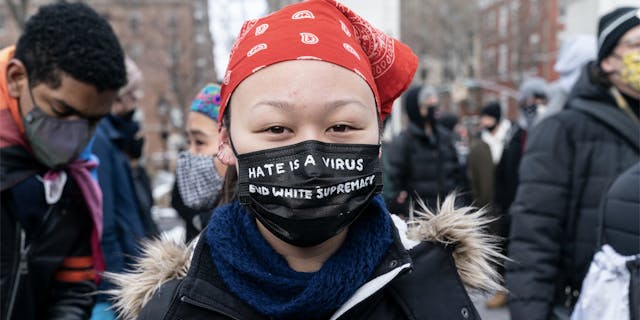“When the murders happened in Atlanta, my school said nothing.”
On March 16, 2021, a 21-year-old white man went on a targeted shooting rampage across Atlanta, driving 30 miles to three massage businesses and killing eight people, the majority of whom were Asian women. Upon capture and questioning, the shooter evoked long-standing, entrenched tropes of sexual violence, racism and misogyny to justify the slaughter. In a year where hate crimes targeting Asian Americans spiked over 300 percent and one in five Asian Americans reported experiencing an anti-Asian hate incident, this shooting was particularly traumatic for a community already reeling from having a target on its back.
The morning after the news broke, however, Asian American educators across the country largely had to show up for work as if nothing out of the ordinary had happened. When they look back on that day, many remember feeling very alone.
In one Philadelphia-area public school district, a K-8 teacher recalled, “We had an online morning meeting every day, and still, nothing was said in that morning meeting. My frustration level was massive because I was such a wreck over it.”
In upstate New York, a high school English teacher said, “I remember driving into school not wanting to go in, being really sad and just crying. I thought to myself, ‘I don't have anyone that I could talk to in my entire school that has any idea about what's going on right now.’”
Meanwhile, in a department meeting in a Boston-area high school, three Asian American educators “chose to be vulnerable because we needed to share. We needed to know that our colleagues could listen to us, in part for us, but also in part so they could do that for our AAPI students. It was hard when nobody really said anything afterwards,” an English teacher remembered, adding that she was shocked that the conversation “just went on to the state-mandated test that was coming up.”
These responses—and lack of responses—were deeply troubling to many Asian American educators. The silence from colleagues and school leadership was particularly invalidating. As one fourth-grade teacher in Colorado reflected, “If we as teachers are consistently feeling like our identities are not honored, imagine how our students must feel in these spaces.”
The voices above represent just a handful of the 80 Asian American K-12 educators who gathered with EdSurge Research in the summer of 2022 to connect in small groups and reflect on their experiences working in U.S. schools in recent years. The raw pain of having to show up for “business as usual” at work while trying to process horrific events like the racially-motivated murder of Atlanta massage workers came up frequently in these conversations. So did the immense weight of alarming and escalating waves of anti-Asian violence that strategically target elders, women, non-binary and LGBTQIA folks, immigrants, Muslims and other marginalized and vulnerable Asian Americans in communities across the nation.

Despite hailing from vastly different geographies and circumstances, the dozens of educators we talked with shared that they often struggled in their own school communities with feeling both hyper-visible and invisible as Asian Americans. This is true in everyday interactions but especially so during these societal flashpoints. Teachers also told us about the constant pressure and expectation they feel to be the representative spokesperson for their race, or sometimes for all people of color, while also having to figure out how to keep their jobs and sanity. On top of that, they reported that they encounter damaging stereotypes and discriminatory moments with their students and colleagues, often with little to no institutional support.
We at EdSurge Research are shining a light on Asian American educators to uplift their unique stories and experiences. We hope to show the many ways that each person in a school can work to build awareness across differences and foster stronger connections that ultimately better support everyone.
What Do Asian American Teachers Experience?
As part of our Voices of Change project exploring how school communities are adapting to meet the needs of all learners, particularly in response to the pandemic and ongoing national reckoning with structural and systemic racism, EdSurge Research launched a research and community engagement project exploring the racialized experiences of Asian American K-12 educators and how school communities can better support them.
Our study focuses on this group of educators in particular because, although Asian Americans hail from a multitude of ethnic and religious groups and are among the fastest growing racial groups in the country (projected to surpass 46 million people in the U.S. by 2060), they represent only 2 percent of educators in the U.S. This means that in school settings, Asian American educator experiences are often underrepresented, overlooked, marginalized or mischaracterized. They’re not just glaringly missing from formal education research and policy decisions, but also limited to reductive stereotypes in common public understanding.
From the playground to the White House, this has direct implications for the lived realities of millions of Asian Americans. This caustic combination of biased or incomplete information and a lack in public awareness very easily fuels damaging stereotypes of Asians as perpetually and dangerously foreign and “taking over” what are seen as limited resources, especially during times of social and economic instability and widening gaps in wealth and income inequality. This evokes fear and mistrust, which can lead to ostracization and poor treatment at its mildest, or as we have seen far too often recently, outright anti-Asian hostility and violence at its worst. This plays out in all facets of society, but seeps into classrooms, school hallways, staff meetings and principals’ offices.

Through this research project, we seek to amplify Asian American K-12 educator voices to deepen public understanding about the diversity of who Asian American educators are, as well as to show the specific, overt and nuanced tensions they have to navigate in order to protect and garner support—for themselves and their students.
First, We Listened
Over the summer, our research team kicked off a series of eight virtual learning circles, structured small group conversations where we brought 80 K-12 Asian American educators together to talk about their experiences and learn together. We invited participation from all U.S.-based educators who identify as Asian American in primary and secondary education settings, and we were overwhelmed with the sheer number of people who wanted to connect, share resources and build community. Although scheduling prevented us from being able to engage with everyone this time around, our research team was fortunate enough to speak with a wide range of Asian American educators who each brought a wealth of knowledge and professional experience, and who embody the diversity of this racial group—hailing from varied ancestries, immigration histories, economic circumstances, genders, sexual orientations, religions and geographies.
We talked with Asian American educators whose families have been in the U.S. for generations, and also with newcomers grappling with disorienting experiences of racialization as “Asian” when they had never been placed in that category before. We talked with educators with mixed and multiracial backgrounds, as well as with adopted children of non-Asian parents and families. We talked with educators who immigrated as children to the U.S., some who grew up on food stamps, in gangs, or as refugees escaping the ravages of war. We talked with folks who strongly identify with their heritage ancestry, language and culture and others who navigate the complex nuances of diasporic reality.
This diverse group of Asian American educators joined our discussions from all over the country, including from Hawaii, Massachusetts, South Dakota, Colorado, California, Missouri, New York, Vermont, Washington, Illinois, Pennsylvania, Florida and Texas. They brought perspectives from serving at all types of educational institutions—public, private, charter, parochial—and at all levels of the education system, in and outside of the classroom. They are K-12 classroom teachers of language and literacy, science, history, math and music; school counselors; learning, tech and special ed coaches; and principals and administrators in urban, suburban and rural communities. They serve and engage daily with a wide range of diverse student populations—including those most negatively affected by racial and economic disparity in the U.S. such as Black, Indigenous, Pacific Islander and Latino students—often teaching and working at the heart of these communities for decades.
What We Heard
Across this beautiful tapestry of unique Asian American backgrounds and circumstances, these educators also shared many experiences they have in common as Asians in America. Because there are so few of them, they told us they struggle with stereotypical and problematic everyday interactions, and isolation and loneliness as a result of workplace stress, especially when trying to deal with overt and unintentional expressions of interpersonal and institutionalized racism that continue to be exacerbated by the pandemic and volatile social context. They also shared stories of celebration and resilience, including the resources and community they’ve found that helped them cope and find moments of belonging, hope, inspiration and joy.

What’s to Come
In the coming months, we will be sharing some of our findings from these in-depth conversations with educators, including:
- Stories showing both the diversity of the group and the specific ways Asian Americans are racialized in schools, as well as the heavy mental tax that accompanies having to negotiate these charged interactions at their workplaces.
- The profound and lasting impact of community care versus silence and inaction after experiencing catastrophic social events on Asian American community members.
- The sense of isolation when they don’t know who they can turn to for support.
- Workplace repercussions for speaking out about everyday experiences of overt stereotyping and racism, interpersonal conflicts, or structural discrimination sanctioned by institutions.
- Their lifelong development of racial identity, and how they can healthily model and provide safe environments for their students to develop and grow.
And finally, we also hope to share the many big and small ways that school and community members can support these educators and provide spaces where everyone can feel safe and have room to flourish and grow.


